Birds have always captivated human attention with their bright plumage, rhythmic flight patterns, and songs. A pond provides a unique habitat for birds, as it offers them a moist environment with an abundance of food sources.
Ponds attract a diverse range of bird species, from predators like the sharp-shinned hawk to waterfowl like the mallard duck. Beyond serving as a home for these feathered creatures, ponds also play a vital role in preserving ecosystems and supporting biodiversity.
In this article, we explore the world of birds in ponds, highlighting the various species that rely on these habitats and their role in maintaining ecological balance.
1. Common Kingfisher
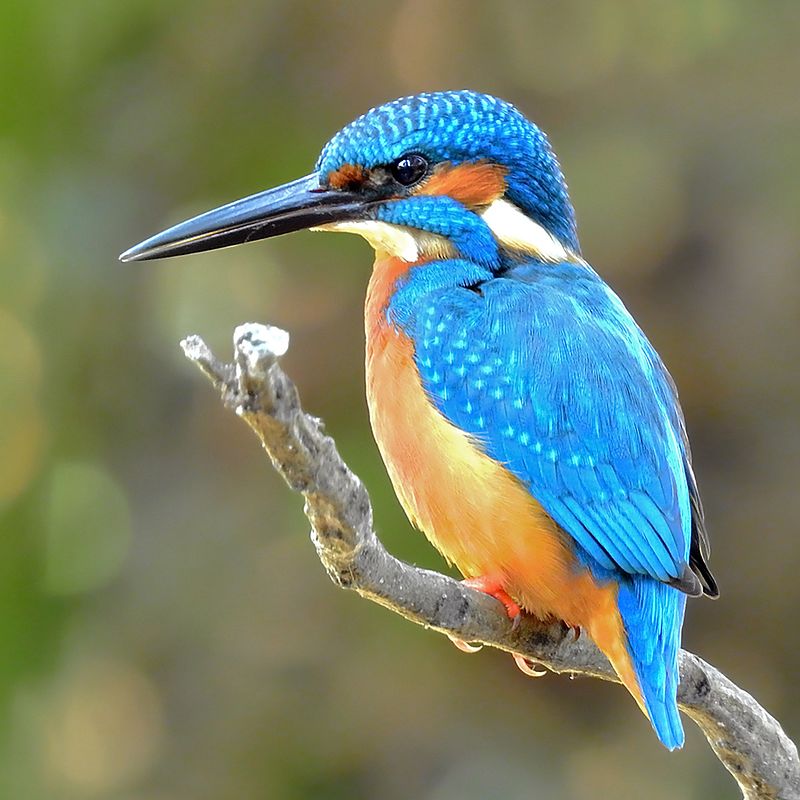
The Common Kingfisher is a small, sparrow-sized bird that can be found across Eurasia and North Africa. It has the typical short tail and large head of kingfishers with seven different subspecies recognized in its range.
They are mainly resident birds but will migrate away during winter when rivers freeze over. The species usually live near bodies of water such as streams or lakes.
Where they hunt for fish by diving from above into the water after spotting their prey below them.
These brightly coloured birds have an unmistakable vibrant blue plumage along with orange underparts and white patches on their wings which makes them easy to recognize amongst other similar looking species.
Their call is loud and shrill making it one of the most recognizable sounds heard around wetlands throughout Europe.Scientific classification:
| Kingdom | Animalia |
| Phylum | Chordata |
| Class | Aves |
| Order | Coraciiformes |
| Family | Alcedinidae |
| Subfamily | Alcedininae |
| Genus | Alcedo |
| Species | A. atthis |
Also Featured In: Common Birds in India, Ukrainian Birds You Should Know
2. Kingfisher
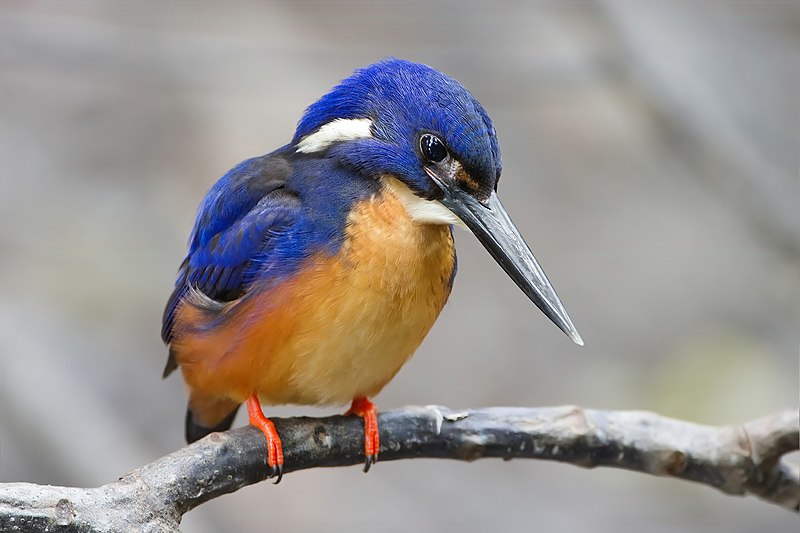
Kingfishers are a vibrant and unique family of birds, with most species found in tropical regions across Africa, Asia, Oceania and Europe.
Their bright colors make them easily identifiable among the foliage of deep forests near calm ponds or rivers.
They come in three subfamilies: tree kingfishers (Halcyoninae), water kingfishers (Cerylinae) and river kingfishers (Alcedinidae).
Kingfisher birds have short legs used for perching along branches overhanging streams or lakes; they also possess strong beaks perfect for catching fish.
These little hunters will remain motionless as if suspended from thin air until an unsuspecting prey comes within reach.
Then they swoop down quickly to grab their meal. With 116 different species making up this incredible family, there’s something special about every single one.Scientific classification:
| Kingdom | Animalia |
| Phylum | Chordata |
| Class | Aves |
| Order | Coraciiformes |
| Suborder | Alcedines |
| Family | Alcedinidae Rafinesque, 1815 |
Also Featured In: African Birds, Most Common Lake Birds
3. Mallard
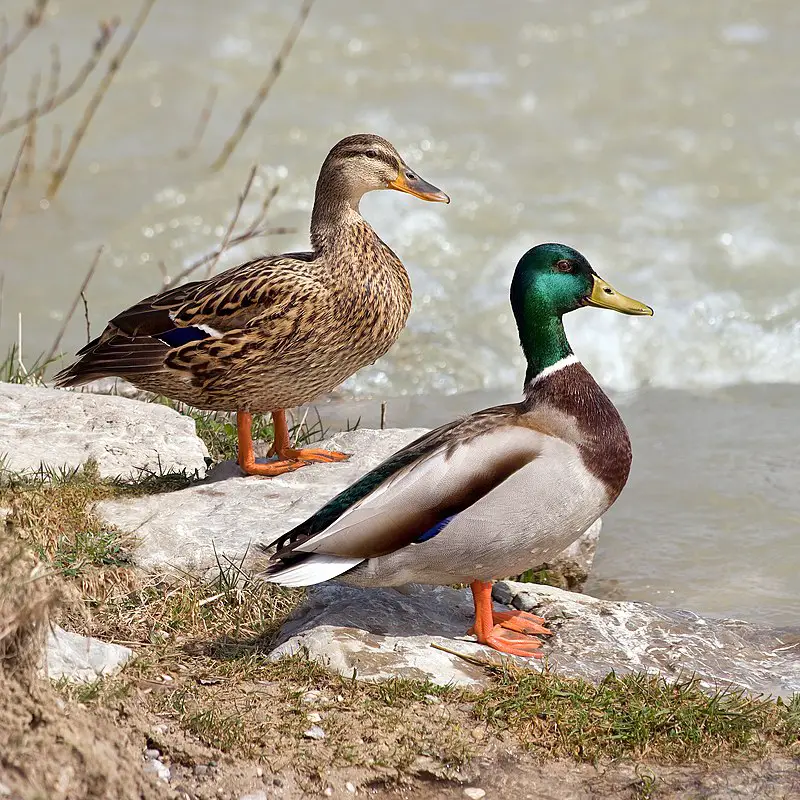
The Mallard is a species of dabbling duck that can be found living in temperate and subtropical regions across the Americas, Eurasia and North Africa.
It has been introduced to other areas such as New Zealand, Australia, Peru, Brazil and South Africa by humans.
This beautiful bird belongs to the Anatinae subfamily of waterfowl family Anatidae. The adult mallards have a glossy green head with white neck ring surrounding.
It along with brownish grey body feathers making them look stunning when they fly away or just sitting in their natural habitat around lakes or ponds.
They are excellent swimmers too due to webbed feet which helps them swim fast underwater while looking for food like aquatic insects etc.. Their loud quacking sound makes them quite popular among nature lovers.Scientific classification:
| Kingdom | Animalia |
| Phylum | Chordata |
| Class | Aves |
| Order | Anseriformes |
| Family | Anatidae |
| Genus | Anas |
| Species | A. platyrhynchos |
Also Featured In: Most Popular Bird Species in North America, Common Birds in the Cities
4. Canada Goose
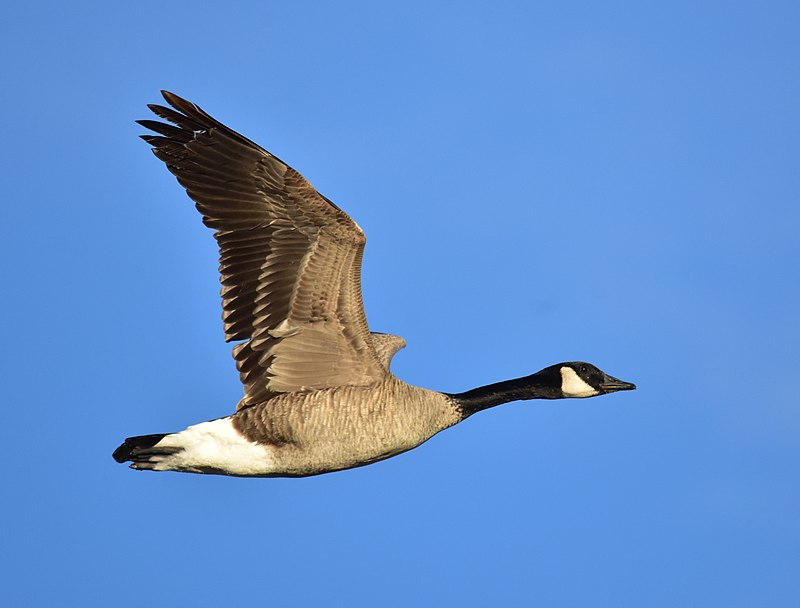
The Canada goose is a majestic bird with a black head and neck, white cheeks, chin and brown body. It’s native to North America but occasionally migrates to northern Europe across the Atlantic.
The species has been introduced in the United Kingdom, Ireland and Finland as well. Canada geese are strong flyers that travel in flocks for protection from predators; they also form monogamous pairs for life.
They feed on grasses or grains near ponds or wetlands where they make their nests of down which incubate eggs during summertime before hatching them out into goslings later on.Scientific classification:
| Kingdom | Animalia |
| Phylum | Chordata |
| Class | Aves |
| Order | Anseriformes |
| Family | Anatidae |
| Genus | Branta |
| Species | B. canadensis |
Also Featured In: Birds Live in Arkansas, Birds that Live in San Francisco Bay Area
5. Herons
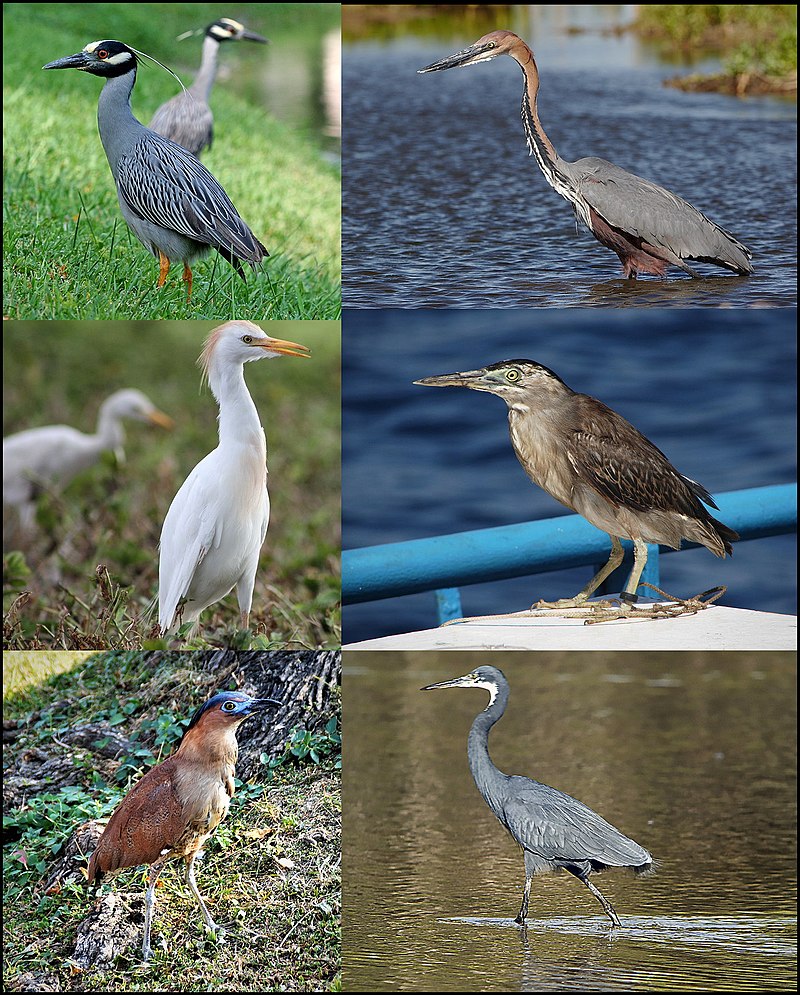
Herons are graceful and elegant birds belonging to the family Ardeidae, with 72 distinct species.
They have long legs and necks that are well-adapted for wading in shallow water like streams or ponds.
Herons can be found near freshwaters as well as along coastal areas worldwide.
Some of these species may also be referred to as egrets, bitterns or zigzag heron/bittern because they belong to certain genera such as Botaurus and Ixobrychus respectively.
These birds stand tall when searching for food by standing still in a shallow body of water while waiting patiently until prey appears before quickly capturing it with their sharp bills.Scientific classification:
| Kingdom | Animalia |
| Phylum | Chordata |
| Class | Aves |
| Order | Pelecaniformes |
| Suborder | Ardei |
| Family | Ardeidae Leach, 1820 |
Also Featured In: Most Common Types of Bangladeshi Birds, Famous Paintings Birds
6. Grey Heron
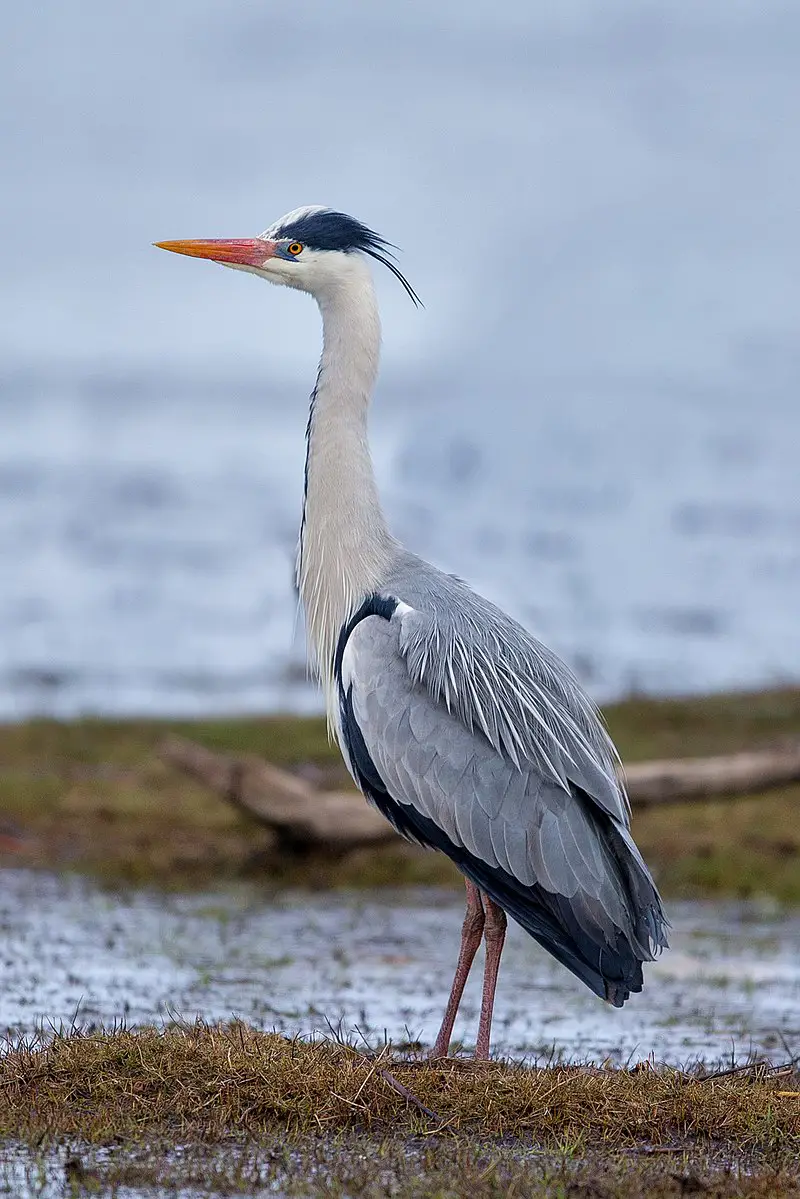
The grey heron is a majestic bird found in temperate regions of Europe, Asia and parts of Africa. It has long legs to wade through the shallow waters where it feeds on aquatic creatures such as frogs, fish and insects.
In wintertime some migrate southwards but others stay put in their natural habitats; lakes, rivers and marshes. They can also be spotted near coasts or along estuaries.
Grey Herons have beautiful blue-grey feathers and an impressive wingspan that makes them stand out from other birds when they soar gracefully across the sky.
These graceful creatures are not only easy on the eye but wise hunters too.Scientific classification:
| Kingdom | Animalia |
| Phylum | Chordata |
| Class | Aves |
| Order | Pelecaniformes |
| Family | Ardeidae |
| Genus | Ardea |
| Species | A. cinerea |
Also Featured In: Common Birds in Japan, Most Common Romanian Birds
7. Little Egret
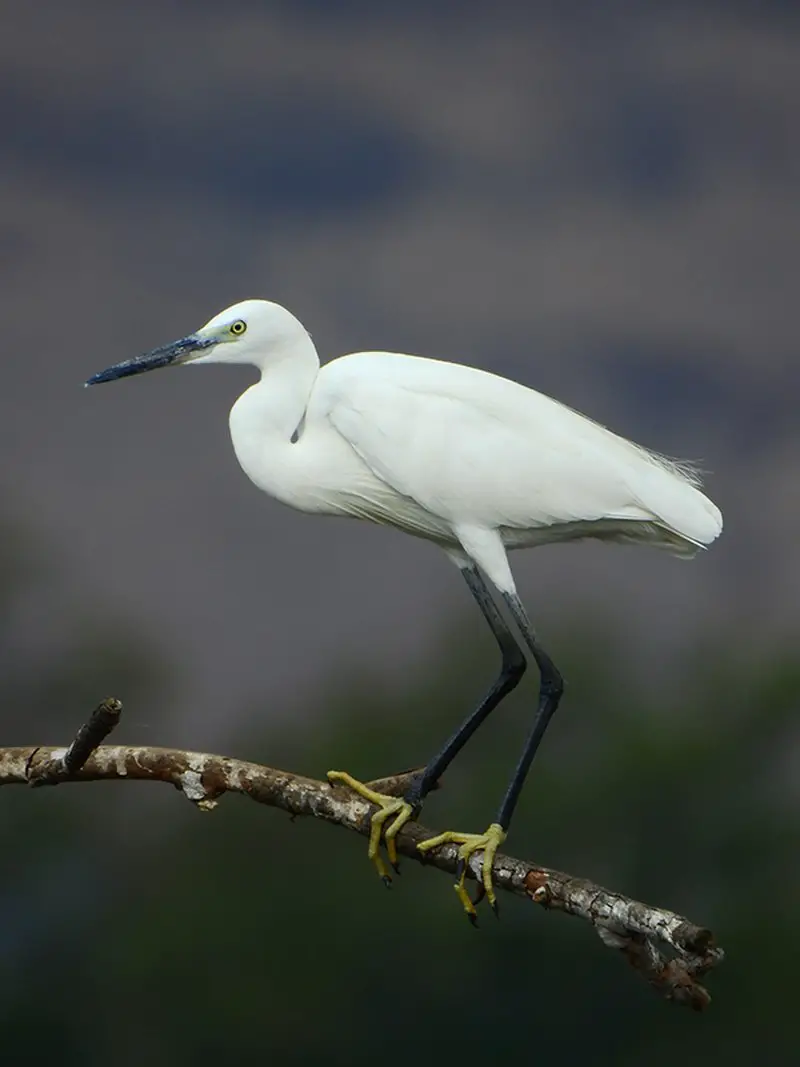
The Little Egret is a small white heron with sleek black beak, long black legs and in some cases yellow feet.
It can be found near aquatic areas where it feeds on molluscs, amphibians and insects while also occasionally feeding of land creatures such as lizards or rodents.
Breeding seasonally they make platform nests of sticks being built either by themselves or in colonies alongside other water birds.
They are widely distributed across the world from Europe to Africa, Asia to Australia making them an easily recognisable bird species often seen at waterside locations searching for their next meal.Scientific classification:
| Kingdom | Animalia |
| Phylum | Chordata |
| Class | Aves |
| Order | Pelecaniformes |
| Family | Ardeidae |
| Genus | Egretta |
| Species | E. garzetta |
Also Featured In: Egyptian Birds, Swamps Birds You Should Know
8. Great Cormorant
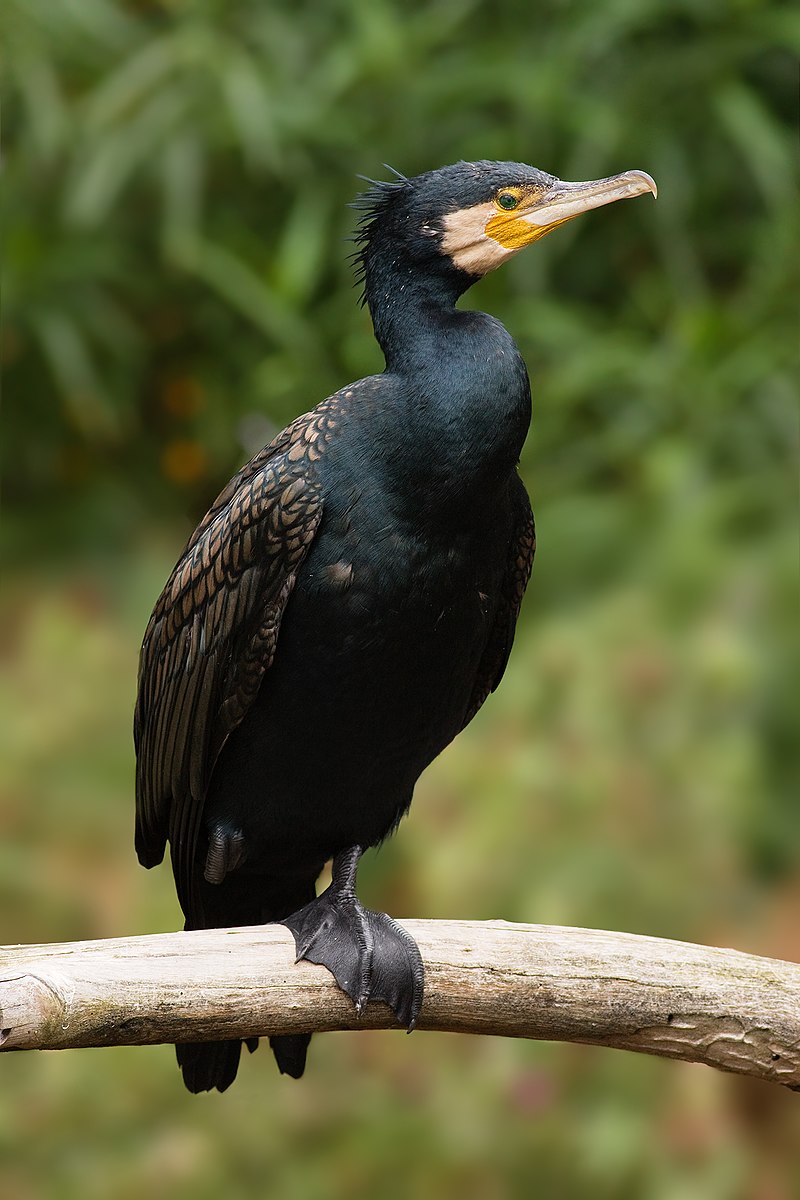
The Great Cormorant is a large seabird belonging to the cormorant family. It has many names, including Black Shag in New Zealand and Large Cormorant in India.
Its striking black feathers make it easy to recognise along coastlines or near bodies of water. The bird can measure up to 1 metre long with a wingspan of around two metres and weighs roughly 3 kilograms.
In flight, its neck is stretched out straight ahead while its bill points downwards – an unmistakable sight for any keen observer.
Cormorants are strong swimmers and excellent divers, frequently going underwater in search of food such as fish or crustaceans that they scavenge from the ocean floor.
They live primarily on coasts but have also been seen inland where there are suitable waterways available – providing another opportunity for nature lovers hoping to catch a glimpse of this impressive species.Scientific classification:
| Kingdom | Animalia |
| Phylum | Chordata |
| Class | Aves |
| Order | Suliformes |
| Family | Phalacrocoracidae |
| Genus | Phalacrocorax |
| Species | P. carbo |
Also Featured In: Native Birds Of Germany, Common Estonian Birds
9. Great Egret
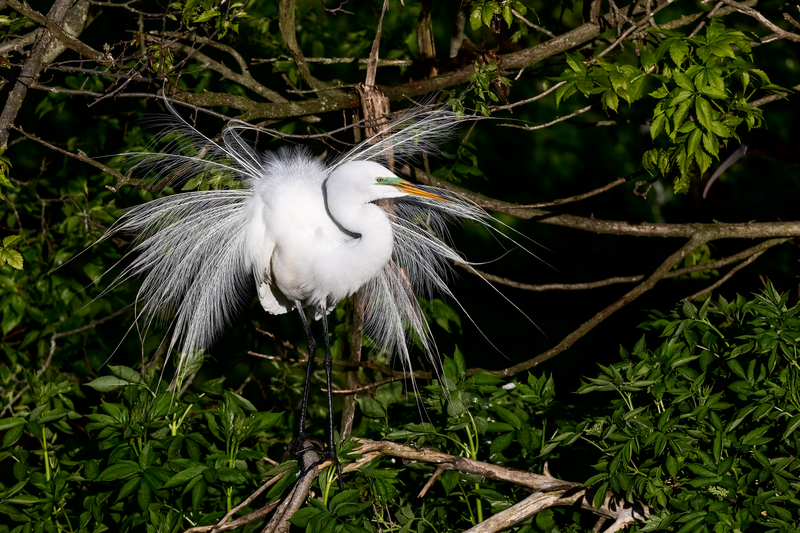
The Great Egret is a large, white bird found in many regions of the world. It has four subspecies that reside across Asia, Africa, Americas and southern Europe.
This species usually lives near bodies of water such as lakes and marshes. They are also now starting to spread into more northern areas of Europe due to climate change.
These birds have long yellow legs with an impressive wingspan for their size which allows them to soar majestically through the sky hunting for fish or amphibians in shallow waters below.
Their feathers have been used historically by Native Americans as part of traditional garments or ceremonies but this practice should be avoided today so these amazing creatures can thrive without harm from humans.Scientific classification:
| Kingdom | Animalia |
| Phylum | Chordata |
| Class | Aves |
| Order | Pelecaniformes |
| Family | Ardeidae |
| Genus | Ardea |
| Species | A. alba |
Also Featured In: Most common Birds in France, Birds that Live around Southwest Florida
10. Eurasian Coot
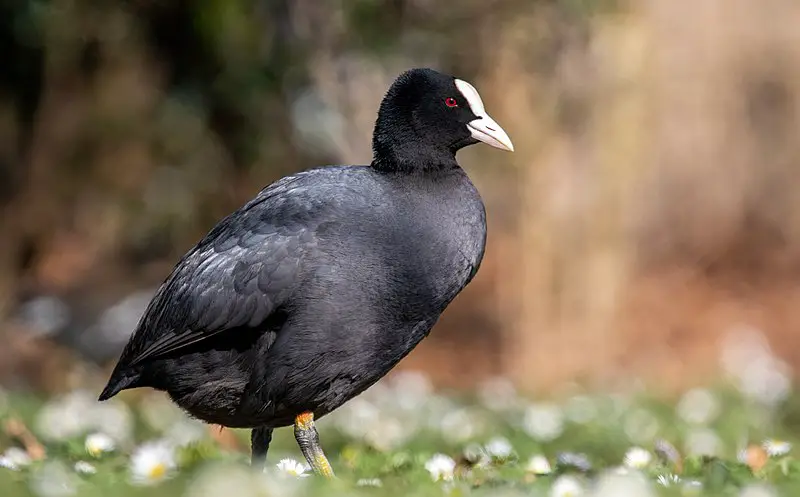
The Eurasian Coot is a water bird belonging to the Rallidae family. It has an overall slaty-black body with a glossy black head and white bill, along with a white frontal shield.
Both male and female coots look similar in appearance. This species can be found across Europe, Asia, Australia, New Zealand and parts of North Africa – making it quite widespread.
In terms of behavior they usually feed on aquatic plants as well as insects while swimming or walking on land near bodies of water such as ponds or lakes.
They are also known for their aggressive nature when defending nesting sites from other birds during breeding season.Scientific classification:
| Kingdom | Animalia |
| Phylum | Chordata |
| Class | Aves |
| Order | Gruiformes |
| Family | Rallidae |
| Genus | Fulica |
| Species | F. atra |
Also Featured In: Birds of Poland, Belarus Birds You Should Know
11. Intermediate Egret
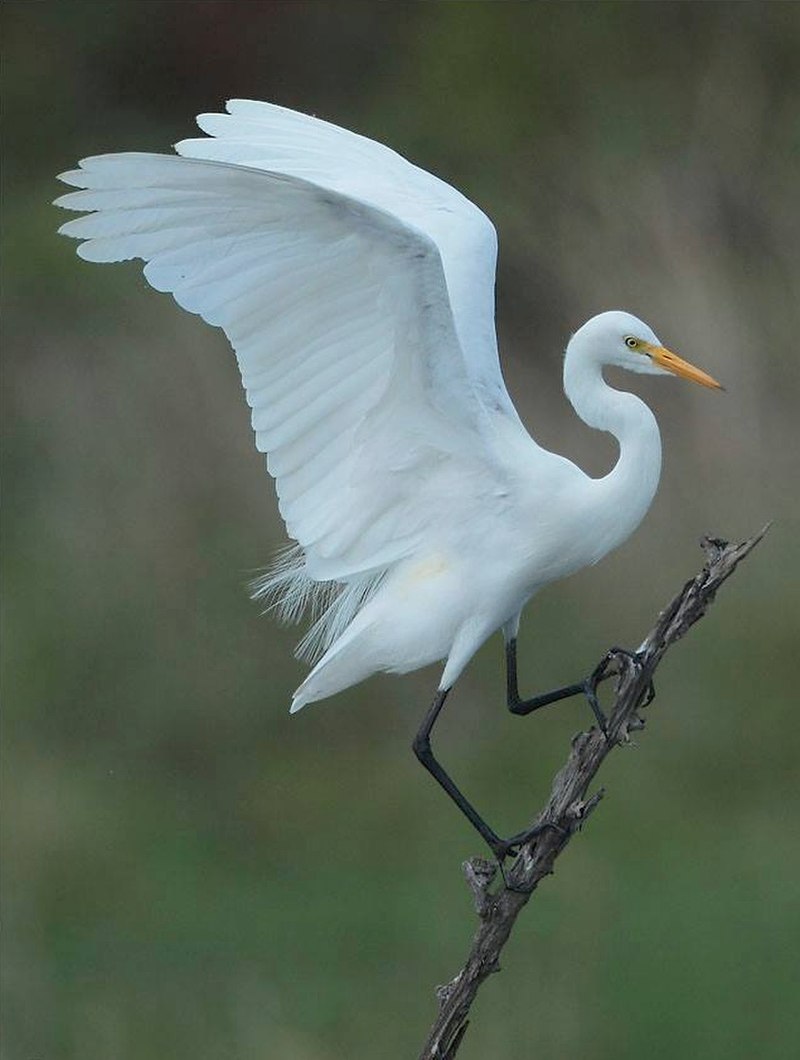
The Intermediate Egret is a medium-sized heron native to East Africa, the Indian subcontinent, Southeast Asia and Australia. It has yellow bill with black tip, chestnut legs and feet.
Its plumage varies from white in breeding season to greyish or brownish non-breeding season. It feeds on small fish, insects and frogs near freshwater habitats such as lakes, marshes and ponds.
They are commonly seen perched atop tall trees where they hunt for prey during low tides at estuarine areas like mudflats or mangroves swamps.
During nesting time they build nests of sticks high up in trees which can be reused year after year if left undisturbed by humans or predators.
The Intermediate Egret is an adaptable bird that offers great potentials for conservation efforts due its wide range across different continents.Scientific classification:
| Kingdom | Animalia |
| Phylum | Chordata |
| Class | Aves |
| Order | Pelecaniformes |
| Family | Ardeidae |
| Genus | Ardea |
| Species | A. intermedia |
Also Featured In: Mauritius birds, Birds that Live in Sunshine Coast
12. Wood Duck
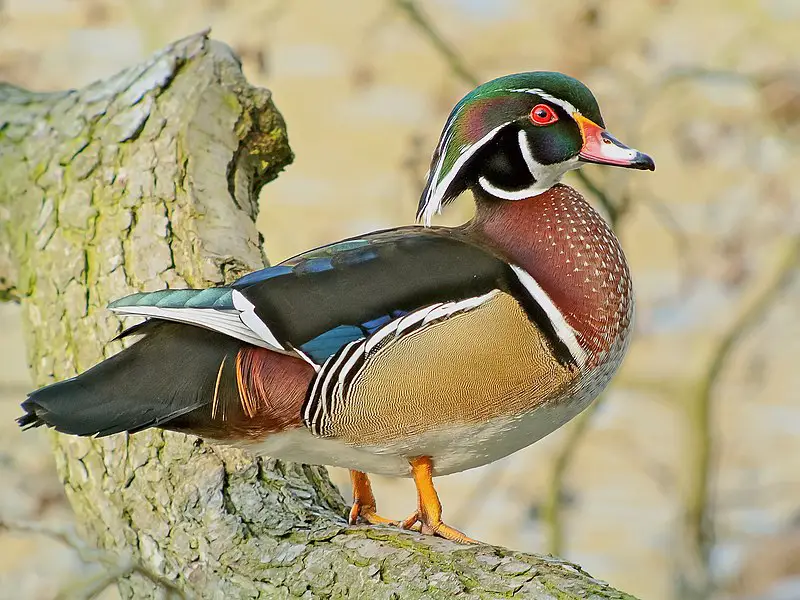
The wood duck, also known as the Carolina Duck, is a species of perching duck native to North America. It is renowned for its beautiful plumage and vibrant colors.
On average, an adult wood duck stands at 19-21 inches in length with a wingspan ranging from 26 to 29 inches. Its weight typically falls between 454–800 grams depending on gender and seasonality.
This medium-sized bird can be seen swimming or perched atop branches near bodies of water like lakes, ponds and rivers – where it feeds mostly on aquatic plants and insects.
The female builds nests inside cavities in trees close to these waters while the male protects her eggs during incubation period until they hatch into adorable little chicks.
Wood ducks are beloved by many due their stunning looks which make them popular subjects among photographers too.Scientific classification:
| Kingdom | Animalia |
| Phylum | Chordata |
| Class | Aves |
| Order | Anseriformes |
| Family | Anatidae |
| Genus | Aix |
| Species | A. sponsa |
Also Featured In: birds of New Mexico, Water Birds Live around Us
13. Little Grebe
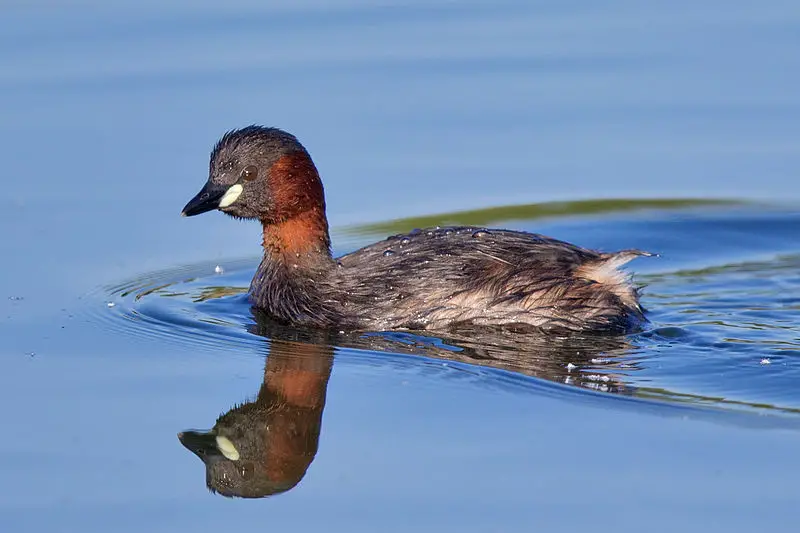
The little grebe, also known as dabchick, belongs to the grebe family and is a small water bird. It gets its genus name from the Ancient Greek words for ‘fast’ and ‘to sink under’.
The specific name ruficollis means ‘red-necked’ in Latin. With a length of 23 to 29 centimetres, it is the smallest member of the grebe family.Scientific classification:
| Kingdom | Animalia |
| Phylum | Chordata |
| Class | Aves |
| Order | Podicipediformes |
| Family | Podicipedidae |
| Genus | Tachybaptus |
| Species | T. ruficollis |
Also Featured In: Turkey Birds You Should Know, Italian Birds You Should Know
14. Common Moorhen
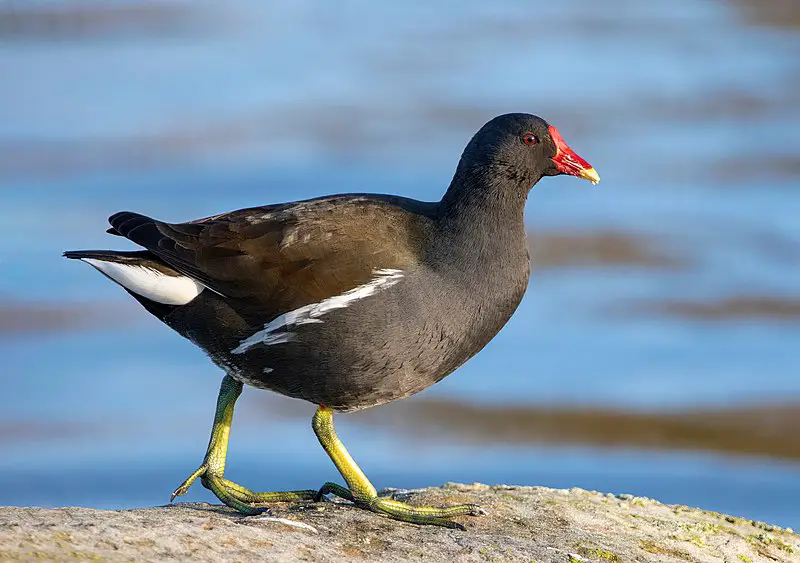
The common moorhen, also called waterhen or swamp chicken, belongs to the rail family and is widespread across various regions of the Old World.
These birds prefer to inhabit wetlands like canals, marshes, and ponds with rich vegetation. They are not found in polar regions or some tropical rainforests.
The species is known for its distinctive red forehead shield, which becomes more prominent during breeding season. Common moorhens usually feed on aquatic plants, small fishes, and invertebrates.
They are excellent swimmers and divers, but are also able to walk on floating vegetation. When threatened, they can flee by diving and swimming underwater.
Overall, common moorhens are fascinating birds that add to the diversity of wetland ecosystems.Scientific classification:
| Kingdom | Animalia |
| Phylum | Chordata |
| Class | Aves |
| Order | Gruiformes |
| Family | Rallidae |
| Genus | Gallinula |
| Species | G. chloropus |
Also Featured In: Birds of Kauai, Hawaii, Wetlands Birds You Should Know
15. Great Reed Warbler
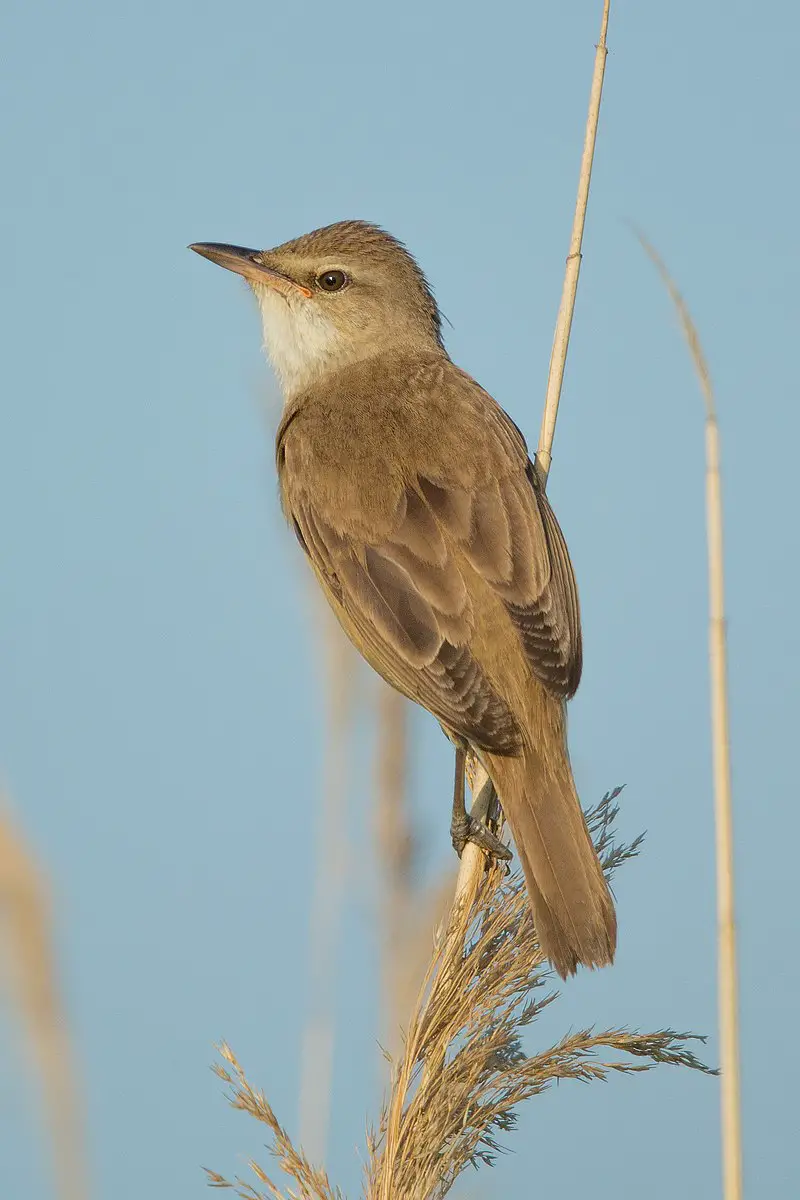
The Great Reed Warbler is a Eurasian bird and belongs to the genus Acrocephalus. This slender bird has a flat head, long tail, and a pointed beak. Its plumage is mostly brown with some streaks on the chest and abdomen.
Great Reed Warblers are known for their singing ability and can produce a variety of melodious sounds.
They usually breed in reed beds and wetlands, and their diet consists of insects and spiders. They were previously part of the Old genus, but now they are classified in their own genus.
The name Acrocephalus comes from Greek, meaning ‘highest head,’ while the specific name, arundinaceus, refers to its reed-like appearance. The Great Reed Warbler is a migratory bird and spends its winter in tropical Africa.Scientific classification:
| Kingdom | Animalia |
| Phylum | Chordata |
| Class | Aves |
| Order | Passeriformes |
| Family | Acrocephalidae |
| Genus | Acrocephalus |
| Species | A. arundinaceus |
Also Featured In: Common Slovakian Birds, Birds You’ll Find in Moldova
16. Eurasian Wigeon
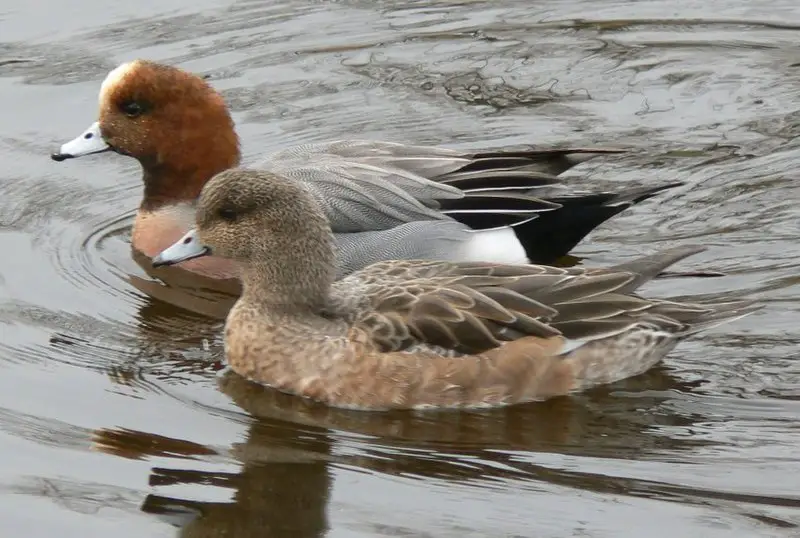
The Eurasian wigeon, also known as the widgeon, is a dabbling duck found throughout its Palearctic range. This species belongs to the genus Mareca and is one of three species of wigeons.
Carl Linnaeus described the Eurasian wigeon in 1758 under the binomial name Anas penelope. This bird is common and widespread across its range.
The Eurasian wigeon is a beautiful bird with a distinctive yellow forecrown, pink breast, and gray-blue beak, and is known for its whistling call.
They are often found in wetlands, where they feed on aquatic plants and invertebrates. The male has a striking breeding plumage, with a chestnut head and neck, gray body, and black-and-white wings.
The female is less colorful, with a brown head and a mottled brown body. This bird is important for both its ecological and cultural value.Scientific classification:
| Kingdom | Animalia |
| Phylum | Chordata |
| Class | Aves |
| Order | Anseriformes |
| Family | Anatidae |
| Genus | Mareca |
| Species | M. penelope |
Also Featured In: Tokyo Birds You Need to Know, Common Snow Birds You Need to Know